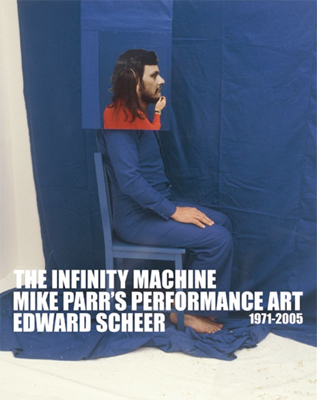Scan Magazine: 2011-04-01
Book Review: Edward Scheer, The Infinity Machine: Mike Parr's Performance Art 1971-2005 (Melbourne: Schwartz City)

Edward Scheer’s book-length study of Mike Parr’s performance art takes time as its central idea. Of the many salient themes commonly associated with Parr’s work, time may not immediately strike the observer as the most pertinent. Violence, pain, shock, ordeal, confrontation, the body, sexuality, political oppression and censorship all register as contenders for leitmotif status. In a career spanning four decades, Parr’s use of various media forms and devices also stands out. But it is to Scheer’s great credit that he makes a compelling case for time as the key theme in Parr’s oeuvre, even incorporating the radically different phases of the artist’s work from 1971 to 2005.
Scheer marshals substantial evidence to support his argument, not least statements made by Parr himself, in interviews and various texts. ‘Time for me is the meaning of performance art,’ Parr wrote in a letter in 1979. Scheer’s analysis operates on both the general level – surveying Parr’s body of work as a whole – and at the specific level of individual works. In the general mode, Scheer observes early in the book that
Parr’s performances heighten the perception of time: they slow it down in a kind of meditation, or quicken it in the manner of a traumatic episode.
In a similar vein, Scheer remarks that in its extensive use of imaging systems, including video and webcasting, Parr’s performances ‘resemble time-based media art’. These general claims are supported by dissections of specific works, such as Malevich (A Political Arm), performance for as long as possible (2002), whose goal is described as ‘to force the spectator, along with object, into time.’ Parr’s early shock pieces are revealed as operating ‘a kind of dialectic with the present, in an alternating time of shock (the present) and recovery (delay).’
In order to sustain his argument, Scheer needs a conceptual underpinning that may be deployed with reference to the many phases of Parr’s career. The key in this regard is the notion of ‘duration’, understood as
a specific construction of time, a deliberate shaping of it to effect a particular experience for the viewer or the audience.
This application of duration as a conceptual term draws on the philosophy of Bergson, with its concept of ‘real duration’ as ‘simple flux, a continuity of flowing, a becoming.’ Bergson conceptualised duration as a fluid, non-chronological, non-linear form of time. Scheer finds this poetics of time expressed everywhere in Parr’s work. The ‘aesthetics of duration’ is disclosed as a ‘central component’ in works as different as the early shock pieces, with their rapid attacks, and the slow ritual performances of the 1990s. With duration as his key analytical concept, Scheer is able to recognise Parr’s recent performance works and installations as combining both the earlier ‘time signatures’.
Scheer divides Parr’s career into five distinct phases. These comprise the fast and violent ‘self-aggressive’ performances of the 1970s; a second phase organised around Black Boxes, room-sized cubes containing performances and image-worlds; the Self-Portrait project of the 1980s which used a variety of media; the Bride performances culminating in 2000; and the fifth phase, from 2001-2005, more explicitly political in its engagement with Howard-era conservatism.
Scheer makes a convincing case for duration as a theoretical means of interpreting all these diverse phases. The political works of the fifth phase, for example, are rendered as engagements with ‘historical time’ – the neo-Conservative manipulation of national identity through national history. The fast and confronting shock works, and the extremely long ordeal works, both function, in their different modes, as a ‘restoration of sense perception as the fundamental aesthetic experience.’ For Scheer, Parr’s performance art resensitises the audience to the world, ‘encouraging the audience to come at it anew with the slightly strange perspective of the artist or the alien.’ Whether by ‘jerking’ the audience back to the ‘immediate moment’, or by forcing audience members to contemplate sheer endurance and the passing of time, Parr’s work achieves ‘a subtle transformation of perception’, in which the limits surrounding the work and the self are ‘rendered temporal’.
Scheer provides detailed readings of all five phases of the artist’s career, from the perspective of time. While the argument of the book is cogent, my only reservation concerns some of the other possible means of interpreting Parr, which are occluded due to the book’s concentration on time. The theme of ordeal, for example, reflected in the pain and exhaustion experienced by the performer, particularly in some of the later politically explicit works, may have warranted greater attention. The description of performances as ‘secular rituals’, coupled with the odd reference to Parr’s intense preparations and physical ordeals experienced in performance, hint at another key to interpretation, perhaps based in the Shamanistic tradition of discovery through ordeal.
Yet that would perhaps be the subject of another book. Scheer has made a persuasive case here for understanding Parr’s art though the prism of time. The Infinity Machine is superbly illustrated and designed (although the flourishing t of the font is distracting and unnecessary). Most importantly, Scheer has made a valuable contribution, not only to the study of Parr but of performance art in general. The Infinity Machine is that rare thing: a book that is both intellectually compelling in its conceptual base and illuminating in its description of the art.